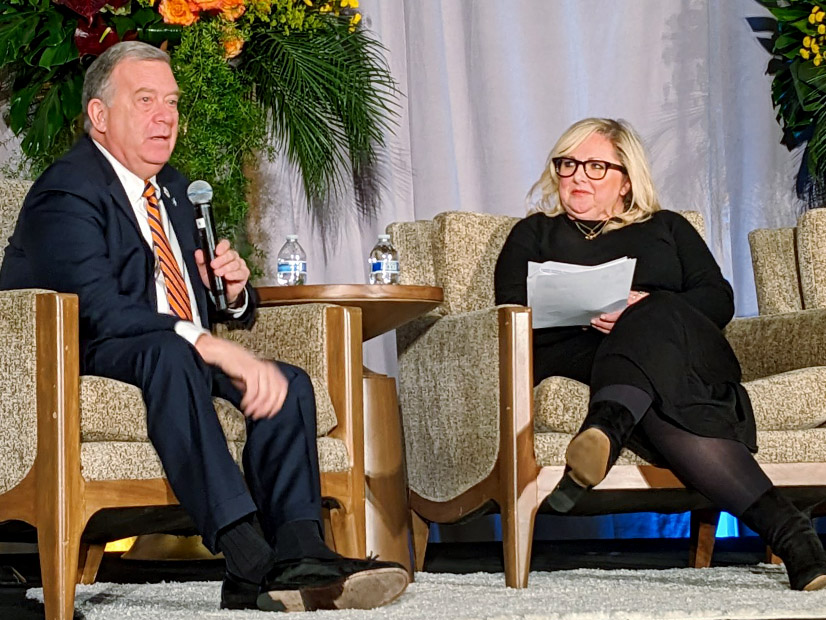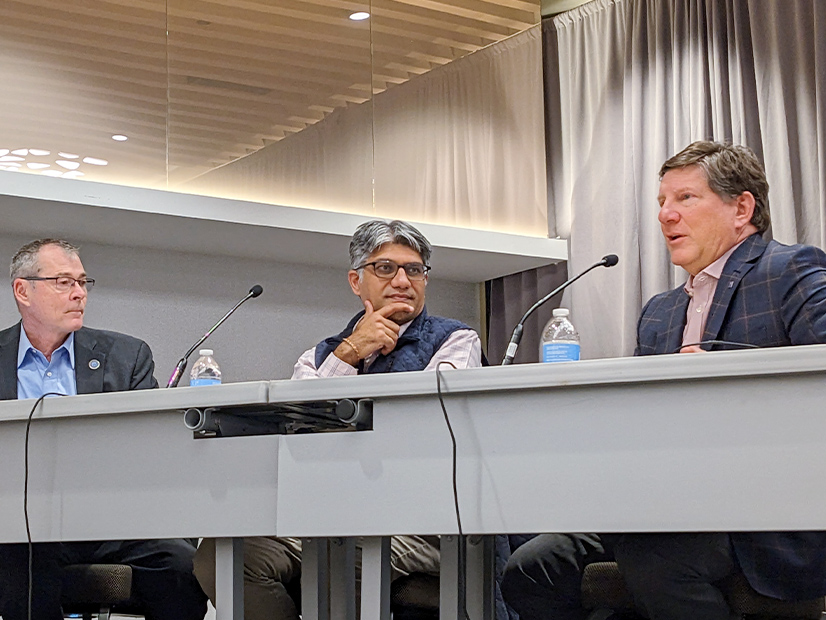
WASHINGTON ― The Tennessee Valley Authority has set its sights on 80% carbon-free generation by 2035 and a net-zero system by 2050, with plans to develop a fleet of up to 20 small modular nuclear reactors to meet the utility’s need for increasing amounts of secure, decarbonized electricity, according to CEO Jeff Lyash.
“I have no interest in building one reactor,” Lyash said during a session on nuclear development at the National Association of Regulatory Utility Commissioners (NARUC) Winter Policy Summit on Sunday. “In order for us to be successful, TVA needs something on the order of 20 reactors over that period of time. So, if you can’t see your way to reaching nth-of-a-kind costs, supply chain, workforce, project execution for a portfolio of reactors, I don’t see the point in building one.”
Approved by the TVA board in February 2022, the federally owned utility aims to build its first SMR at its Clinch River location in Tennessee, which now has an early site permit from the Nuclear Regulatory Commission. Separate from a construction permit, this permission provides safety, environmental impact and emergency preparedness approvals for a site where one or more nuclear plants may be built.
TVA will still need a construction permit for the 300-MW GE Hitachi BWRX-300 SMR it is now considering for potential deployment at Clinch River. The utility’s goal is not only to show that the technology works, Lyash said, but that it can be deployed “in a way where you can demonstrate the ability to build enough reactors to materially affect the outcome we’re looking for, which is energy security, decarbonization in the face of electrification and economic growth.”
The rising profile of nuclear power as one of the critical technologies that will power the U.S. to a carbon-free grid was a major theme at the NARUC conference, with Sunday’s session followed on Monday by an on-stage interview with David Wright, a member of the Nuclear Regulatory Commission.

Introducing Wright, who is also a past president of NARUC, Commissioner Tricia Pridemore, chair of the Georgia Public Service Commission, announced the formation of a new Advanced Nuclear State Collaborative, which will bring together members of NARUC and the National Association of State Energy Officials. The Department of Energy is sponsoring the initiative, which will provide technical assistance and expertise for states deploying or considering new nuclear projects, Pridemore said.
The initiative is one answer to the growing interest in nuclear across the country. In at least 20 states, “public service commissions and state energy offices are engaged in feasibility studies for advanced nuclear reactor site selection, strategies to reduce regulatory and policy barriers to new nuclear, and other activities to pave the way for advanced reactors,” she said.
Wright also sees possibilities for the NRC to develop more active relationships with state commissions and policy makers. “There are things [utility commissions] are going to be involved in that need our expertise or maybe even just information,” he told Pridemore.
“There are things you’re going to want to do, and you’re going to want to know — ‘Can I do that?” he said. “Do we have to put certain regulations in place on the state level, or does the legislature have to do certain things?’”
But a bigger question looms for the U.S. nuclear industry and its supporters, including TVA and DOE, which is pouring billions into the development of advanced reactors: Can they adequately de-risk a technology known for massive cost overruns and project delays to build the trust of financial markets and the public at large ― and how fast can they do it?
The Value of Vogtle
The two units nearing completion at the Alvin W. Vogtle Electric Generating Plant near Waynesboro, Ga., are a case in point. Vogtle’s two existing reactors have been operating since the late 1980s, but the plant’s next-generation expansion has become the poster project for cost overruns and delays, with Georgia’s rate payers picking up the tab with higher electric bills to finance construction.
The first new nuclear generation built in the U.S. in 30 years, the project is now six years behind schedule, and its original cost estimate of $14 billion has ballooned to more than $30 billion. Vogtle has also received $12 billion in loan guarantees from the Department of Energy’s Loan Programs Office (LPO), made during both the Obama and Trump administrations.
The first new unit at Vogtle is now expected to come online in May or June, a delay from the previous target of the end of April, Georgia Power said Feb. 16. The second unit is scheduled to begin commercial operation between this November and March 2024. Georgia Power also wrote off $201 million in additional costs for the reactors, reflecting increased costs. Together, the two units will provide 1,250 MW of power.
With completion finally in sight, the industry narrative on the troubled project is focused on its upside and long-term benefits.
Joining Lyash for Sunday’s nuclear discussion, LPO Director Jigar Shah said that Vogtle shows that “America is deciding to do big things. …
“We had to train 13,000 men and women, who were all union, to build those projects, and we now have that trained workforce, and many of those folks paid off debt for their entire families,” Shah said. “I think the transformational nature of what Vogtle did is something that we should celebrate, celebrating the persistence, the spirit of nuclear to get that done.”
That persistence also paid off in Poland’s recent decision to choose the same Westinghouse AP1000 reactors soon to go online at Vogtle for its first nuclear project, Shah said.
Similarly, Lyash sees Vogtle as a first-of-its-kind project that has produced valuable lessons learned. “The key is to have the fortitude and the confidence to harvest those learnings and integrate them and to use [them] to benefit the nation,” he said.

“And those lessons are around project management and execution, risk management, what a supply chain looks like, what the workforce needs to look like,” he said. “Vogtle has helped build the end capabilities now that I’ll be taking advantage of if we move forward with the BWRX-300.”
Despite Vogtle’s problems, Lyash predicted that “a decade from now, you’re going to be very, very happy that you have those facilities. They’re going to be impacting the economy and the environment, and they have generated a design that is beginning to be deployed around the world.”
Shah said, even today, the LPO would provide the same loan guarantees to the project. A key point for such decisions is whether the office sees “a realistic prospect of repayment,” and he expects Vogtle will fully repay its loans.
‘A Fragile System’
The positive momentum for nuclear at NARUC notwithstanding, opinions nationwide about moving forward with new plants remains divided. In its most recent poll on the issue, Gallup found support for nuclear edging up to 51% versus 47% opposed, a slight shift from 2019, when the country was evenly split, 49% to 49%.
A Pew Research poll taken before Russia’s invasion of Ukraine last year found that 35% of those surveyed said the U.S. government should support nuclear; 25% said the government should not support it; while 37% were neutral on the issue.
Opinions also differ on the cost of maintaining the country’s existing 92 nuclear reactors, which provide about 20% of the nation’s power and 50% of its carbon-free electricity.
At the Sunday session, Commissioner John B. Howard of the New York Public Service Commission raised the issue of state subsidies for existing plants, such as New York’s zero-emission credits (ZECs) “that many believe are not affordable and sustainable.”
Nuclear power development has gotten too expensive, Howard said.
A recent NARUC report on the U.S. nuclear market lists New York, Illinois, Connecticut, New Jersey and Ohio as providing ZECs for their existing plants. The Infrastructure Investment and Jobs Act also provides $6 billion in funding for a Civil Nuclear Credit Program to help plants stay open.
But Lyash countered that nuclear plants are “highly competitive.”
According to the NARUC report, more than two-thirds of the clean power supply in 20 states comes from nuclear, and in Mississippi, nuclear accounts for 96% of the state’s carbon-free power.
Nuclear is 42% of TVA’s power supply, Lyash said, and he expects that percentage to hold steady even as the utility’s electricity demand increases with economic growth and electrification of buildings and transportation.
Nuclear plants are “high capital on the front end, but they have a tremendously long and beneficial life,” he said. “They also deliver all the attributes to a power system that you need — voltage, frequency, maneuverability.”
Echoing a familiar nuclear industry argument, Lyash said ZECs should not be seen as subsidies, but rather as paying nuclear plants “for the value that they already delivered because markets have a difficult time recognizing that.”
Shah framed the case for nuclear in terms of system reliability. “We have a fragile system, and that fragility has come from [independent power producer]-run natural gas plants,” he said. “For the last three years, we have seen a historic amount of failure out of those gas plants. … For many people, nuclear power represents a better form of baseload clean power to be able to provide that to people long term, [but] what they are afraid of is that we haven’t figured out how to build them on time, on budget.”
TVA’s Clinch River project could be the next step toward that goal, he said.
Lyash countered that the issue was not system fragility, per se, but the rising expectations of customers who are themselves increasingly dependent on electricity. “If you roll back 75 years, only about 2% of all the end-use energy in this country came from electricity; today it is 22%, and by 2050, it’s probably going to be 50%,” he said.
“The level of reliability on the U.S. electric system hasn’t generally degraded,” Lyash said. “The customer expectations have risen, and not just day-in, day-out reliability … but resiliency — how does it perform when it’s [confronted] with the thing you hoped would never happen or happens infrequently,” such as December’s Winter Storm Elliott.
“People’s expectations are entirely different. … Twenty years ago if your lights went out for 20 minutes, or flickered, you would not have cared,” he said. “Today you really care about this.”
‘No Shortcuts’
Lyash also sees SMRs, like the BWRX-300, as easier to integrate on the grid. Smaller reactors could be strategically sited to ease transmission congestion, and in the event of an emergency, taking 300 MW offline would be less disruptive to system reliability than bigger units, he said.
Lyash, Shah and Wright are expecting nuclear development in the coming years to be centered on or near closed coal-fired plants with existing transmission, circumventing the need for extensive new transmission construction.
Shah pointed to a recent DOE study that identified 157 closed coal plants and an additional 237 coal plants still in operation as potential sites for coal-to-nuclear transition. The study also found 80% of those sites well suited for the development of advanced reactors of less than 1 GW.
For example, TerraPower’s 345-MW Natrium reactor, one of two projects being developed under DOE’s Advanced Reactor Demonstration Program, is being planned for Kemmerer, Wyo., where a PacifiCorp coal-fired plant is scheduled for retirement in 2025. The DOE program has $2.5 billion in funding from the Infrastructure Investment and Jobs Act and is supporting the development of two advanced reactors that are scheduled to be online by 2027.
The second reactor, X-energy’s Xe-100, is being planned for a site in Washington state near an existing nuclear plant.
Wright sees these demonstrations and other coal-to-nuclear projects as the “low-hanging fruit” of the next wave of nuclear development. Siting a nuclear project on or near a closed or existing coal or nuclear plant could streamline permitting because “they’ve already got an [environmental impact statement],” he said. “We don’t want to have to do an [analysis] if they’re going on a site that’s already been done. …
“There may be some tweaking to some regulations and rules we have to do in order to get ready, but we don’t want to be the reason that they delay [or] they don’t even get to market,” he said.
NRC is also staffing up in preparation for what it expects to be an increasing number of projects applying for approval, Wright said. “We’re onboarding 400 this year,” he said.
While planning for an aggressive nuclear buildout, Lyash said TVA wants to pursue a diversified portfolio of clean energy resources that balances energy security, affordability and decarbonization. “No one resource can satisfy” these goals, he said. “You have to think about this not as a choice between wind or solar or nuclear or hydro or storage. It’s the combination of all the right technologies in a portfolio that delivers energy security and [clean] energy to drive the economy.”
Shah agreed, saying all resources should be on the table. The enthusiasm for nuclear at NARUC is part of the growing interest in other technologies, such as enhanced geothermal and low-impact hydropower, he said. Going forward, he sees industry enthusiasm and support for “all of the tools that have reached the level of maturity so they can rise to the occasion” of decarbonizing the U.S. economy.
But Shah said the greatest challenge ahead for nuclear may be building trust. “I think the nuclear industry, for better or for worse, was dormant for the better part of 30 years, not really pursuing innovation for the better part of 30 years,” he said. Now the industry is developing SMRs and other innovative advanced reactors, but “they have to do a proper job. They have to learn all the lessons. They’ve got to make sure they measure 34 times and cut once.
“There’s no shortcut to building trust,” Shah said. “It’s about doing these things in a highly competent fashion, making sure there is transparency, that we’re fully admitting all the mistakes that were made in the past and learning from them.”
